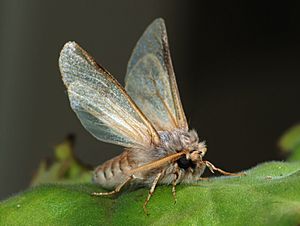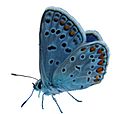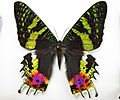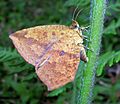Comparison of butterflies and moths facts for kids
Butterflies and moths are both fascinating insects that belong to a group called Lepidoptera. While they might look similar, they have many differences. People often classify them into two main groups: butterflies, which are a natural group called Rhopalocera, and moths, which are called Heterocera. This article will help you understand how to tell them apart!
Contents
What are Butterflies and Moths?
Butterflies are a special group of insects that includes true butterflies (Papilionoidea), skippers (Hesperiidae), and butterfly moths (Hedylidae). Moths make up the rest of the Lepidoptera group. Scientists agree that butterflies form a "monophyletic" group, meaning they all came from a single common ancestor. Moths, however, do not form such a clear-cut group.
Butterfly Families
Here are some of the main families usually considered butterflies:
- Swallowtails and birdwings (Papilionidae)
- Whites or yellow-whites (Pieridae)
- Blues and coppers (Lycaenidae)
- Metalmark butterflies (Riodinidae)
- Brush-footed butterflies (Nymphalidae), which include many well-known butterflies like:
The Hesperiidae, also known as skippers, are often seen as butterflies. However, they have some unique features that make them different from both butterflies and moths. All other families of Lepidoptera are considered moths.
How They Look Different
Antennae Shape
The easiest way to tell butterflies and moths apart is by looking at their feelers, called antennae. Most butterflies have thin, slender antennae with a small club or ball at the end. This is why butterflies are called Rhopalocera, which means "clubbed horn."
Moths, on the other hand, have many different kinds of antennae. They can be feathery, comb-like, or thin, but they almost never have a club at the end. This is why moths are called Heterocera, meaning "varied horn."
There are a few exceptions. Some moths, like the Castniidae family, do have clubbed antennae. And a few butterflies, like Pseudopontia paradoxa, don't have club ends. Skippers often have a bent tip on their antennae.
Wing Connection
Many moths have a special hook-like structure called a frenulum. This hook on their back wing connects to bristles on their front wing, helping them fly together. Some moths also have a small lobe on their front wing called a jugum that helps connect the wings. Butterflies do not have these structures.
Pupae (Cocoons and Chrysalises)
Most moth caterpillars spin a silky case called a cocoon around themselves when they are ready to change into a pupa. Inside the cocoon, they transform.
Most butterfly caterpillars, however, form an exposed pupa called a chrysalis. This chrysalis is usually made of a hardened protein and hangs freely.
But there are exceptions! Some hawk moths form exposed pupae underground. Spongy moths sometimes make cocoons that look like butterfly pupae. Also, some skipper butterfly larvae make simple cocoons.
Wing Colors
Most butterflies have bright, colorful wings. This helps them find mates and warns predators that they might be toxic. Moths that are active at night are usually plain brown, grey, white, or black. They often have patterns that help them blend in with their surroundings during the day.
However, many moths that fly during the day are brightly colored, especially if they are poisonous. They use their colors to warn predators, just like butterflies. Some nocturnal moths, like the giant silk moths, can also have bright colors and striking patterns. A few butterflies, like the cabbage white, are plain-colored.
Body Structure
Moths usually have stout, hairy, or furry-looking bodies. Butterflies, on the other hand, have slender and smoother bodies. Moths have larger scales on their wings, making them look more dense and fluffy. Butterflies have finer scales. This difference might help moths stay warm during cool nights or avoid bats that use sound to find prey. Butterflies can absorb heat from the sunlight.
Eye Types
Butterflies and moths have different types of compound eyes. Moths often have eyes that are good for seeing in low light, which helps them at night. Butterflies usually have eyes that give them clearer vision and better color perception, which is useful during the day.
There are exceptions here too. Some day-flying moths have eyes like butterflies, and some nocturnal butterflies have eyes like moths. This usually happens when their activity time is different from what is typical for their group.
How They Behave Differently
Time of Activity
Most moths are nocturnal (active at night) or crepuscular (active at dawn and dusk). Most butterflies are diurnal (active during the day).
However, there are some amazing exceptions, like the colorful Uraniidae or sunset moths, which fly during the day. Some moths, like the male European/North American spongy moth, fly both day and night to find females.
Resting Posture
Moths usually rest with their wings spread out flat to their sides. Butterflies often fold their wings together above their backs when they are resting. Sometimes, butterflies will spread their wings for short periods to "bask" in the sun. Some swallowtail butterflies often rest with their wings spread when in sunlight.
Skippers can hold their wings flat, folded, or even in a "jet plane" position. Some moths might also fold their wings above their backs if they don't have enough space to spread them out.
A confusing group can be the Geometridae moths, like the winter moth. They often rest with their wings folded vertically, similar to butterflies. However, you can tell them apart by their antennae, which are usually feathery or comb-like, not clubbed.
Examples of Exceptions
-
The male Callosamia promethea moth uses Batesian mimicry to look like the poisonous pipe vine swallowtail butterfly.
See also
 In Spanish: Diferencias entre mariposas diurnas y nocturnas para niños
In Spanish: Diferencias entre mariposas diurnas y nocturnas para niños











